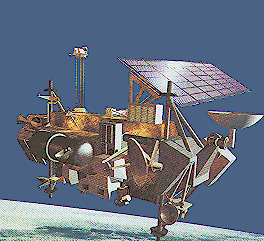 Four instruments (CLAES, ISAMS, MLS, HALOE) measure atmospheric composition
and temperature, two instruments (HRDI, WINDII) observe atmospheric winds,
and three other instruments (SOLSTICE, SUSIM, PEM) measure the energy inputs
from solar radiation and charged particles. A tenth instrument (ACRIM II)
will take advantage of a flight of opportunity to continue NASA's solar
constant measurements.
Four instruments (CLAES, ISAMS, MLS, HALOE) measure atmospheric composition
and temperature, two instruments (HRDI, WINDII) observe atmospheric winds,
and three other instruments (SOLSTICE, SUSIM, PEM) measure the energy inputs
from solar radiation and charged particles. A tenth instrument (ACRIM II)
will take advantage of a flight of opportunity to continue NASA's solar
constant measurements.
Collection Environment
Data are collected from a near circular Earth orbit of about 585 km altitude and 57 degree inclination
Platform Mission Objectives
It is the UARS mission to study the coupled energy inputs, chemistry and dynamics of the upper atmosphere, improve the understanding of natural and man-made perturbations to the upper atmosphere, and to learn more about long term climate effects. The mission objectives also include the study of energy input and loss, photochemistry, and dynamics in the upper atmosphere, coupling among these processes, and coupling between the upper and lower atmosphere. The near complete latitude coverage is achieved by performing a yaw maneuver approximately every 36 days, whereby the spacecraft is rotated 180 degrees to view in the opposite hemisphere along the trajectory path. Thus, coverage is increased from a range of 34S - 80N to a range of 80S - 80N.